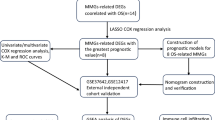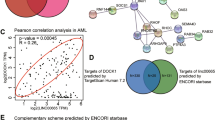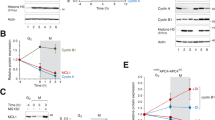Abstract
Acute myeloid leukemia (AML) is a heterogeneous clonal disease. Membrane-associated ring-CH type finger 1 (MARCH1), a membrane-anchored E3 ubiquitin ligase, is highly expressed in AML. However, its role in AML remains unclear. Our study showed that MARCH1 expression was strongly associated with FAB classifications and the survival of patients with AML. Gain-of-function and loss-of-function experiments showed that MARCH1 promoted the proliferation of AML cells and inhibited apoptosis and differentiation. In vivo, MARCH1 knockdown inhibited the infiltration of AML cells, resulting in prolonged survival of AML mice. In order to illustrate what cause the high expression of MARCH1, we analyzed the promoter region of MARCH1 and found that POU2F2, a transcription factor with high levels in AML, positively regulated the transcription of MARCH1. Finally, we demonstrated that MARCH1 interacted with MYCT1, a candidate tumor suppressor, and accelerated its ubiquitination and degradation. Remarkably, MYCT1 knockdown abolished the inhibitory effects of MARCH1 knockdown on AML cell growth. Our findings indicate that MARCH1, whose transcription is positively modulated by POU2F2, facilitates the malignant behaviors of AML cells through interacting with MYCT1 and accelerating its ubiquitination and degradation. The results implied that targeting MARCH1 might be a promising therapeutic strategy for AML.
This is a preview of subscription content, access via your institution
Access options
Subscribe to this journal
Receive 50 print issues and online access
$259.00 per year
only $5.18 per issue
Buy this article
- Purchase on SpringerLink
- Instant access to full article PDF
Prices may be subject to local taxes which are calculated during checkout








Similar content being viewed by others
Data availability
All data generated or analyzed during this study are included in this published article.
References
Pelcovits A, Niroula R. Acute myeloid leukemia: a review. R I Med J. 2020;103:38–40.
Rubnitz JE, Gibson B, Smith FO. Acute myeloid leukemia. Hematol Oncol Clin North Am. 2010;24:35–63.
de Lima MC, da Silva DB, Freund AP, Dacoregio JS, Costa TelJ, Costa I, et al. Acute myeloid leukemia: analysis of epidemiological profile and survival rate. J Pediatr. 2016;92:283–9.
Patel JP, Gonen M, Figueroa ME, Fernandez H, Sun Z, Racevskis J, et al. Prognostic relevance of integrated genetic profiling in acute myeloid leukemia. N Engl J Med. 2012;366:1079–89.
Yu B, Liu D. Gemtuzumab ozogamicin and novel antibody-drug conjugates in clinical trials for acute myeloid leukemia. Biomark Res. 2019;7:24.
Deng L, Meng T, Chen L, Wei W, Wang P. The role of ubiquitination in tumorigenesis and targeted drug discovery. Sig Transduct Target Ther. 2020;5:11.
Wei Z, Su L, Gao S. The roles of ubiquitination in AML. Ann Hematol. 2024;103:3413–28.
Cheng Y, Hu Y, Wang H, Zhao Z, Jiang X, Zhang Y, et al. Ring finger protein 19A is overexpressed in non-small cell lung cancer and mediates p53 ubiquitin-degradation to promote cancer growth. J Cell Mol Med. 2021;25:7796–808.
Li C, Du L, Ren Y, Liu X, Jiao Q, Cui D, et al. SKP2 promotes breast cancer tumorigenesis and radiation tolerance through PDCD4 ubiquitination. J Exp Clin Cancer Res. 2019;38:76.
Yang Q, Zhao J, Chen D, Wang Y. E3 ubiquitin ligases: styles, structures and functions. Mol Biomed. 2021;2:23.
Senft D, Qi J, Ronai ZA. Ubiquitin ligases in oncogenic transformation and cancer therapy. Nat Rev Cancer. 2018;18:69–88.
Oh J, Wu N, Baravalle G, Cohn B, Ma J, Lo B, et al. MARCH1-mediated MHCII ubiquitination promotes dendritic cell selection of natural regulatory T cells. J Exp Med. 2013;210:1069–77.
Borges TJ, Murakami N, Machado FD, Murshid A, Lang BJ, Lopes RL, et al. March1-dependent modulation of donor MHC II on CD103(+) dendritic cells mitigates alloimmunity. Nat Commun. 2018;9:3482.
Wilson KR, Liu H, Healey G, Vuong V, Ishido S, Herold MJ, et al. MARCH1-mediated ubiquitination of MHC II impacts the MHC I antigen presentation pathway. PLoS One. 2018;13:e0200540.
Xie L, Dai H, Li M, Yang W, Yu G, Wang X, et al. MARCH1 encourages tumour progression of hepatocellular carcinoma via regulation of PI3K-AKT-beta-catenin pathways. J Cell Mol Med. 2019;23:3386–401.
Meng Y, Hu J, Chen Y, Yu T, Hu L. Silencing MARCH1 suppresses proliferation, migration and invasion of ovarian cancer SKOV3 cells via downregulation of NF-kappaB and Wnt/beta-catenin pathways. Oncol Rep. 2016;36:2463–70.
Liang W, Zhang T, Huo J, Yang J. MARCH1 promotes the growth and maintaining of stem cell-like characteristics of gastric cancer cells by activating the Wnt/beta-catenin signaling pathway. Tissue Cell. 2022;78:101895.
Friedl EM, Matthias P. Transcriptional activation and repression, two properties of the lymphoid-specific transcription factor Oct-2a. Eur J Biochem. 1995;234:308–16.
Yang R, Wang M, Zhang G, Li Y, Wang L, Cui H. POU2F2 regulates glycolytic reprogramming and glioblastoma progression via PDPK1-dependent activation of PI3K/AKT/mTOR pathway. Cell Death Dis. 2021;12:433.
Luo R, Zhuo Y, Du Q, Xiao R. POU2F2 promotes the proliferation and motility of lung cancer cells by activating AGO1. BMC Pulm Med. 2021;21:117.
Wang SM, Tie J, Wang WL, Hu SJ, Yin JP, Yi XF, et al. POU2F2-oriented network promotes human gastric cancer metastasis. Gut. 2016;65:1427–38.
Advani AS, Lim K, Gibson S, Shadman M, Jin T, Copelan E, et al. OCT-2 expression and OCT-2/BOB.1 co-expression predict prognosis in patients with newly diagnosed acute myeloid leukemia. Leuk Lymphoma. 2010;51:606–12.
Yue PJ, Sun YY, Li YH, Xu ZM, Fu WN. MYCT1 inhibits the EMT and migration of laryngeal cancer cells via the SP1/miR-629-3p/ESRP2 pathway. Cell Signal. 2020;74:109709.
Qu SY, Sun YY, Li YH, Xu ZM, Fu WN. YY1 directly suppresses MYCT1 leading to laryngeal tumorigenesis and progress. Cancer Med. 2017;6:1389–98.
Pu J, Wang J, Xu Z, Lu Y, Wu X, Wu Y, et al. miR-632 functions as oncogene in hepatocellular carcinoma via targeting MYCT1. Hum Gene Ther Clin Dev. 2019;30:67–73.
Rothermund K, Rogulski K, Fernandes E, Whiting A, Sedivy J, Pu L, et al. C-Myc-independent restoration of multiple phenotypes by two C-Myc target genes with overlapping functions. Cancer Res. 2005;65:2097–107.
Rogulski KR, Cohen DE, Corcoran DL, Benos PV, Prochownik EV. Deregulation of common genes by c-Myc and its direct target, MT-MC1. Proc Natl Acad Sci USA. 2005;102:18968–73.
Fu S, Fu Y, Chen F, Hu Y, Quan B, Zhang J. Overexpression of MYCT1 inhibits proliferation and induces apoptosis in human acute myeloid leukemia HL-60 and KG-1a cells in vitro and in vivo. Front Pharm. 2018;9:1045.
Li F, Gao C, Li X, Wang J, Zhao Y, Ke Y, et al. Jiyuan oridonin A induces differentiation of acute myeloid leukemia cells including leukemic stem-like cells. Front Pharm. 2022;13:1001552.
Della Via FI, Shiraishi RN, Santos I, Ferro KP, Salazar-Terreros MJ, Franchi Junior GC, et al. (-)-Epigallocatechin-3-gallate induces apoptosis and differentiation in leukaemia by targeting reactive oxygen species and PIN1. Sci Rep. 2021;11:9103.
Assis PA, De Figueiredo-Pontes LL, Lima AS, Leao V, Candido LA, Pintao CT, et al. Halofuginone inhibits phosphorylation of SMAD-2 reducing angiogenesis and leukemia burden in an acute promyelocytic leukemia mouse model. J Exp Clin Cancer Res. 2015;34:65.
Xu J, Zhang W, Yan XJ, Lin XQ, Li W, Mi JQ, et al. DNMT3A mutation leads to leukemic extramedullary infiltration mediated by TWIST1. J Hematol Oncol. 2016;9:106.
Liu L, Guo B, Han Y, Xu S, Liu S. MARCH1 silencing suppresses growth of oral squamous cell carcinoma through regulation of PHLPP2. Clin Transl Oncol. 2022;24:1311–21.
Tokheim C, Wang X, Timms RT, Zhang B, Mena EL, Wang B, et al. Systematic characterization of mutations altering protein degradation in human cancers. Mol Cell. 2021;81:1292–1308.e11.
Mullighan CG, Zhang J, Kasper LH, Lerach S, Payne-Turner D, Phillips LA, et al. CREBBP mutations in relapsed acute lymphoblastic leukaemia. Nature. 2011;471:235–9.
Papaemmanuil E, Gerstung M, Bullinger L, Gaidzik VI, Paschka P, Roberts ND, et al. Genomic classification and prognosis in acute myeloid leukemia. N Engl J Med. 2016;374:2209–21.
Bullinger L, Dohner K, Dohner H. Genomics of acute myeloid leukemia diagnosis and pathways. J Clin Oncol. 2017;35:934–46.
Huang J, Zhao H, Hong M, Zhu H, Zhu Y, Lian Y, et al. Early recovery of the platelet count after decitabine-based induction chemotherapy is a prognostic marker of superior response in elderly patients with newly diagnosed acute myeloid leukaemia. BMC Cancer. 2018;18:1269.
Wang N, Yang L, Dai J, Wu Y, Zhang R, Jia X, et al. 5-FU inhibits migration and invasion of CRC cells through PI3K/AKT pathway regulated by MARCH1. Cell Biol Int. 2021;45:368–81.
Akhtar N, Baig MW, Haq IU, Rajeeve V, Cutillas PR. Withanolide metabolites inhibit PI3K/AKT and MAPK pro-survival pathways and induce apoptosis in acute myeloid leukemia cells. Biomedicines. 2020;8:333.
Jiang X, Lin Y, Zhao M, Li Y, Ye P, Pei R, et al. Platycodin D induces apoptotic cell death through PI3K/AKT and MAPK/ERK pathways and synergizes with venetoclax in acute myeloid leukemia. Eur J Pharm. 2023;956:175957.
Nagarajan A, Petersen MC, Nasiri AR, Butrico G, Fung A, Ruan HB, et al. MARCH1 regulates insulin sensitivity by controlling cell surface insulin receptor levels. Nat Commun. 2016;7:12639.
Ablack JN, Metz PJ, Chang JT, Cantor JM, Ginsberg MH. Ubiquitylation of CD98 limits cell proliferation and clonal expansion. J Cell Sci. 2015;128:4273–8.
Prasad, Atul R, Kolla VK, Legac J, Singhal N, Navale R, et al. Blocking Plasmodium falciparum development via dual inhibition of hemoglobin degradation and the ubiquitin proteasome system by MG132. PLoS One. 2013;8:e73530.
Schneider SM, Lee BH, Nicola AV. Viral entry and the ubiquitin-proteasome system. Cell Microbiol. 2021;23:e13276.
Kim M, Bae JY, Yoo S, Kim HW, Lee SA, Kim ET, et al. 2-Deoxy-d-ribose induces ferroptosis in renal tubular epithelial cells via ubiquitin-proteasome system-mediated xCT protein degradation. Free Radic Biol Med. 2023;208:384–93.
Yang YL, Zhang Y, Li DD, Zhang FL, Liu HY, Liao XH, et al. RNF144A functions as a tumor suppressor in breast cancer through ubiquitin ligase activity-dependent regulation of stability and oncogenic functions of HSPA2. Cell Death Differ. 2020;27:1105–18.
Jensen HA, Yourish HB, Bunaciu RP, Varner JD, Yen A. Induced myelomonocytic differentiation in leukemia cells is accompanied by noncanonical transcription factor expression. FEBS Open Bio. 2015;5:789–800.
Skopek R, Palusinska M, Kaczor-Keller K, Pingwara R, Papierniak-Wygladala A, Schenk T, et al. Choosing the right cell line for acute myeloid leukemia (AML) research. Int J Mol Sci. 2023;24:5377.
Chau D, Ng K, Chan TS, Cheng YY, Fong B, Tam S, et al. Azacytidine sensitizes acute myeloid leukemia cells to arsenic trioxide by up-regulating the arsenic transporter aquaglyceroporin 9. J Hematol Oncol. 2015;8:46.
Recher C, Beyne-Rauzy O, Demur C, Chicanne G, Dos Santos C, Mas VM, et al. Antileukemic activity of rapamycin in acute myeloid leukemia. Blood. 2005;105:2527–34.
Li X, Cheng K, Shang MD, Yang Y, Hu B, Wang X, et al. MARCH1 negatively regulates TBK1-mTOR signaling pathway by ubiquitinating TBK1. BMC Cancer. 2024;24:902.
Acknowledgements
We thank the staff of Department of Hematology Laboratory of Shengjing Hospital of China Medical University for their suggestions on data collation.
Funding
This work was supported by the National Natural Science Foundation of China (NSFC) [grant number: 82070165], Natural Science Foundation of Liaoning Province [grant number: 2023-MSLH-387], Talent Project of Shengjing Hospital [grant number: M1425 and M0957] and National Natural Science Foundation of China (NSFC) [grant number: 82200227].
Author information
Authors and Affiliations
Contributions
JNL, JNX and SF contributed to the study conception and design. Material preparation, data collection and analysis were performed by JNL, JNX, RCS, XHW, FC, YF, HNZ, BW and YY. The first draft of the manuscript was written by JNL and JNX. Experimental materials and technical support were provided by JHZ. The first draft of the manuscript was reviewed and edited by SF. All authors read and approved the final manuscript.
Corresponding authors
Ethics declarations
Competing interests
The authors declare no competing interests.
Ethics approval and consent to participate
This study was approved by the Medical Ethics Committee of Shengjing Hospital of China Medical University and was performed in accordance with the ethical standards as laid down in the 1964 Declaration of Helsinki and its later amendments or comparable ethical standards. All animal experiments were conducted with the approval by Medical Ethics Committee of Shengjing Hospital of China Medical University, and all procedures were line with the Guide for the Care and Use of Laboratory Animals.
Additional information
Publisher’s note Springer Nature remains neutral with regard to jurisdictional claims in published maps and institutional affiliations.
Rights and permissions
Springer Nature or its licensor (e.g. a society or other partner) holds exclusive rights to this article under a publishing agreement with the author(s) or other rightsholder(s); author self-archiving of the accepted manuscript version of this article is solely governed by the terms of such publishing agreement and applicable law.
About this article
Cite this article
Liu, J., Xu, J., Sun, R. et al. MARCH1, transcriptionally regulated by POU2F2, facilitates acute myeloid leukemia progression via inducing MYCT1 degradation. Oncogene 44, 2983–2996 (2025). https://doi.org/10.1038/s41388-025-03464-3
Received:
Revised:
Accepted:
Published:
Issue date:
DOI: https://doi.org/10.1038/s41388-025-03464-3



